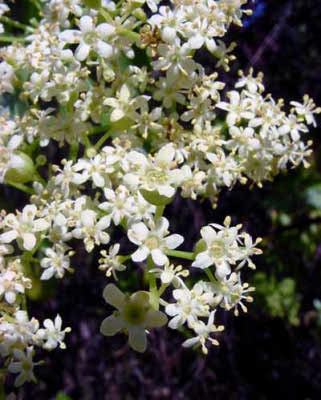
Elderberry makes a good mulch
 Today's traditional soil amendment method
was little more than a footnote in the book, but I'm intrigued by it
nevertheless. In southwest Guatemala, elderberry bushes (sauco) are interplanted amid
vegetable crops. Every year, the farmers cut back the bushes to
stumps, and use the young leaves and branches to mulch around crop
plants. The leaves have a high nitrogen to carbon ratio (a lot
like grass
clippings), so they decompose rapidly, feeding the crop plants in
the process.
Today's traditional soil amendment method
was little more than a footnote in the book, but I'm intrigued by it
nevertheless. In southwest Guatemala, elderberry bushes (sauco) are interplanted amid
vegetable crops. Every year, the farmers cut back the bushes to
stumps, and use the young leaves and branches to mulch around crop
plants. The leaves have a high nitrogen to carbon ratio (a lot
like grass
clippings), so they decompose rapidly, feeding the crop plants in
the process.
The elderberry bushes in Guatemala are closely related to the
elderberry bushes that grow wild here --- depending on who you talk to,
the Mexican Elderberry (Sambucus
mexicana) is either a subspecies or a closely related species to
our Common Elderberry (Sambucus
canadensis.) We have elderberry bushes growing in our
garden that I've tried to eradicate, but which keep sprouting back up
from the stumps. This year, I stopped the eradication campaign
and instead decided to include the bushes as a mulch source in our
forest garden since elderberry flowers are useful nectaries to attract
beneficial insects. I'm intrigued to read that some Guatemalan
farmers also consider elderberries so important that they let them take
up valuable crop space.
| This post is part of our Central American Permaculture lunchtime
series.
Read all of the entries: |
Want more in-depth information? Browse through our books.
Or explore more posts by date or by subject.
About us: Anna Hess and Mark Hamilton spent over a decade living self-sufficiently in the mountains of Virginia before moving north to start over from scratch in the foothills of Ohio. They've experimented with permaculture, no-till gardening, trailersteading, home-based microbusinesses and much more, writing about their adventures in both blogs and books.
Want to be notified when new comments are posted on this page? Click on the RSS button after you add a comment to subscribe to the comment feed, or simply check the box beside "email replies to me" while writing your comment.
- Remove comment
- Remove comment
